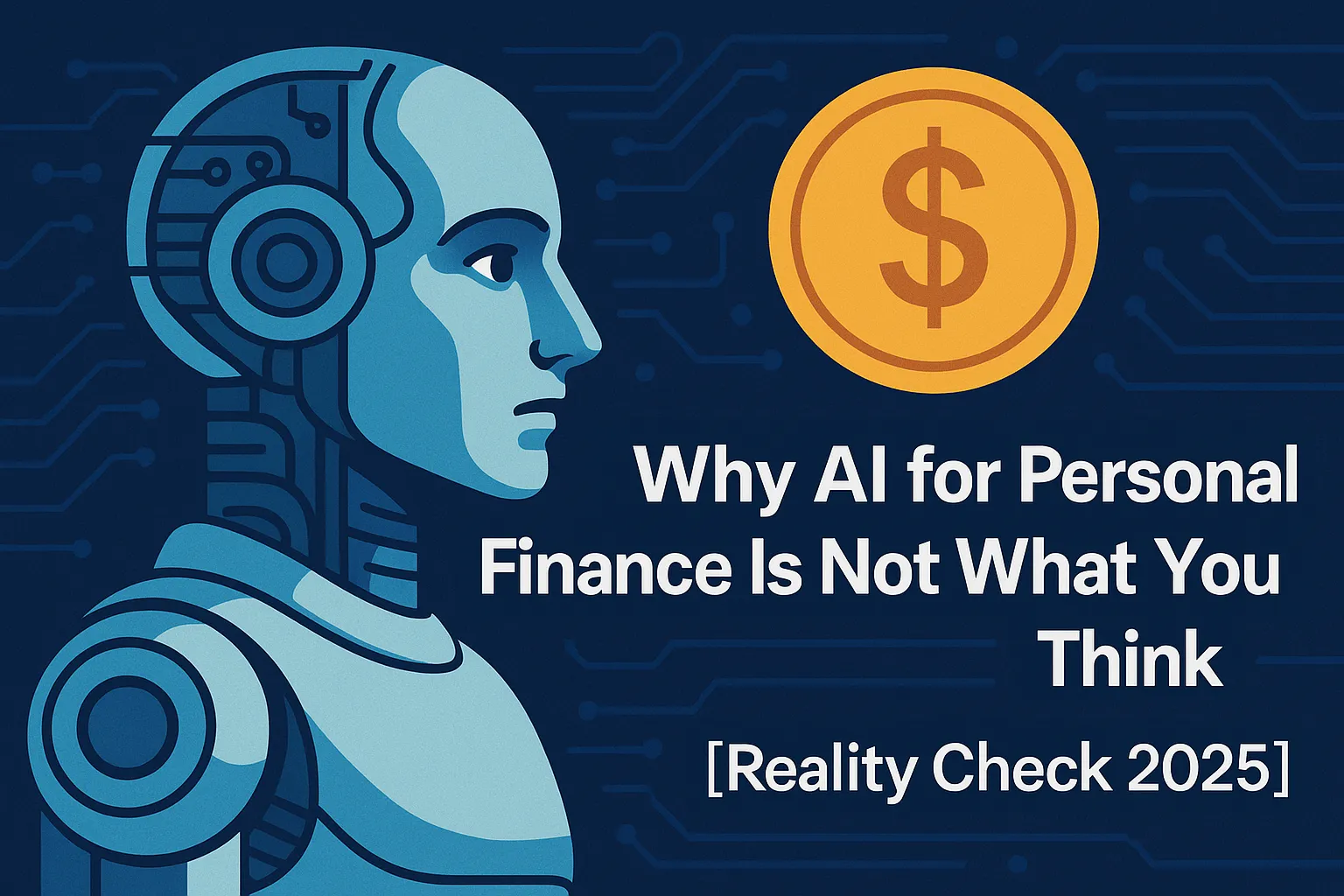Why AI for Personal Finance Is Not What You Think [Reality Check 2025]

AI for personal finance is rapidly transforming how you manage your money, with assets under robo-advisor management projected to more than double from $2.5 trillion in 2022 to $5.9 trillion by 2027. However, beneath the impressive growth lies a more complex reality that few discuss.
While 74% of Gen Z and Millennials are open to using AI-powered financial tools, these technologies come with significant limitations. Despite the adoption of AI in financial planning surging from 45% in 2022 to an expected 85% by 2025, algorithmic bias can lead to discrimination against certain groups in creditworthiness evaluations. Additionally, though AI tools for personal finance can automate budgeting and provide personalized recommendations, they often lack the emotional intelligence needed for complex financial decisions.
This article cuts through the hype to give you a clear-eyed view of what AI can and cannot do for your financial future in 2025 and beyond.
The promises of AI in personal finance
The financial technology landscape has witnessed significant growth in AI-powered tools that promise to simplify money management. Recent surveys show 67% of Gen Zers and 62% of millennials already use artificial intelligence for personal finance tasks. These tools offer three key promises: automation of tedious financial tasks, personalized guidance, and accelerated analysis capabilities.
Automation of budgeting and saving
Traditional budgeting often fails due to the tedious nature of manual tracking. AI addresses this by automatically categorizing expenses, identifying spending patterns, and providing real-time insights into where your money goes. Apps like Mint and YNAB analyze your transactions and sort them into clear categories without requiring manual input.
Furthermore, these tools can alert you when you're approaching budget limits, keeping you accountable in the moment. For many users, this automation delivers measurable results—60% of users report AI tools have helped them with saving and budgeting.
Beyond simple tracking, AI can identify small amounts you can afford to save based on your spending habits and automatically transfer those funds to designated accounts. This "set and forget" approach removes the willpower barrier that often derails saving goals.
Personalized financial recommendations
Generic financial advice rarely addresses your unique situation. AI changes this by analyzing your specific financial behaviors and tailoring recommendations accordingly. The personalization capabilities of AI-driven finance tools have been shown to increase customer engagement by 20-30%.
These systems can evaluate your spending patterns, income fluctuations, and financial goals to create customized strategies. For instance, AI can suggest optimal debt repayment plans or identify opportunities to improve your credit score—a benefit reported by 48% of AI finance tool users.
In investment planning, AI analyzes your risk tolerance and financial situation to recommend appropriate portfolio allocations. This level of personalization was previously available only through expensive financial advisors but is now accessible through AI-powered platforms.
Faster data analysis and decision-making
The computational power of AI enables processing of vast financial datasets at speeds impossible for humans. This capability transforms how quickly you can make informed money decisions.
AI algorithms identify patterns in your financial behavior that might otherwise go unnoticed. These insights allow for proactive financial management rather than reactive responses to problems after they occur.
Machine learning models can analyze both historical data and real-time inputs to generate accurate forecasts about future financial performance. This predictive capability helps you anticipate expenses, optimize savings, and plan for major financial events with greater confidence.
According to a McKinsey report, organizations implementing AI-powered financial tools have seen operational costs reduced by up to 30% while experiencing a 35% boost in customer retention. These efficiency gains translate to better service and potentially lower fees for consumers.
The hidden risks you might not see
Behind the glossy promises of AI-powered finance tools lurk several significant risks that rarely make it into marketing materials. As these technologies become more embedded in financial services, understanding their limitations becomes crucial for protecting your financial well-being.
Over-reliance on AI tools
Excessive dependence on automated financial systems can leave you vulnerable when these systems fail. AI is inherently prone to algorithmic bias, systematically favoring certain outcomes that produce inequitable results. This overreliance creates a dangerous scenario where financial decisions occur without proper human oversight. In extreme cases, automated systems can trigger market instabilities—as demonstrated during the 2010 Flash Crash when algorithmic trading contributed to extreme market volatility.
Misinformation from generative models
AI systems frequently present false information as facts—a phenomenon experts call "hallucinations". Moreover, generative AI models trained on internet text have a high probability of disseminating inaccurate financial advice. Since many AI systems operate with technological knowledge cut-offs, they may not incorporate the most recent financial regulations or market conditions, potentially leading you toward outdated strategies.
Lack of emotional intelligence in decision-making
Although numbers drive finance, successful money management requires emotional intelligence that AI simply cannot replicate. Studies show higher emotional intelligence correlates with more rational financial decision-making. A human financial adviser can recognize unspoken concerns in your expression when discussing a financial plan—something no algorithm can detect. Even as 54% of Americans report using ChatGPT for financial recommendations, these tools cannot provide the empathy essential for navigating complex financial trade-offs.
Privacy and data security concerns
Financial AI requires access to your most sensitive information. Alarmingly, 92% of workers in financial services use personal apps regularly, with 13% uploading sensitive data. This creates substantial vulnerability as 64% of organizations have deployed AI applications with critical security vulnerabilities. Users often share personal details with AI as if conversing with trusted confidants, yet research from Stanford found training data could potentially be recovered from models like ChatGPT.
Where AI tools fall short in real life
Testing AI financial tools in everyday scenarios reveals critical limitations that marketing rarely addresses. The gap between what ai for personal finance promises and what it delivers becomes increasingly apparent when examining its practical applications.
Generic advice that lacks context
AI personal finance tools often generate standardized recommendations without understanding your unique circumstances. These systems frequently offer abstract advice like "stick to a repayment plan" without addressing financial realities or legal consequences. In fact, they typically analyze data based on existing information without distinguishing between genuinely useful guidance and potentially misleading advice. As one finance app CEO noted, "AI can often spit out the most generic and abstract advice, so it's not necessarily giving users real tried-and-tested recommendations". Even MIT Sloan's research confirms that tools like ChatGPT fall short without domain-specific financial training.
Bias in algorithms and training data
AI models trained on historical data inherit and sometimes amplify existing biases. A shocking study from Lehigh University found that AI chatbots were 8.5% more likely to approve white applicants than identical Black applicants with the same financial profile. This disparity widened for applicants with lower credit scores, where white applicants were approved 95% of the time versus less than 80% for Black applicants. Consequently, these systems perpetuate discrimination in lending, reinforcing socioeconomic divisions. The Consumer Financial Protection Bureau has explicitly expanded its regulatory framework to address this issue, acknowledging that algorithmic discrimination constitutes an unfair practice.
Inability to handle complex financial trade-offs
Financial decisions involve balancing numerous personal factors that AI cannot fully comprehend. Essentially, ai tools for personal finance lack the emotional intelligence and personal understanding required for nuanced decision-making. They struggle to grasp the emotional implications of financial choices or the subtleties of individual goals. As one finance app CEO pointed out, "Generative AI has a bad habit of treating all financial trade-offs equally, ignoring the reality that these decisions are rarely black and white". Furthermore, these tools cannot adapt to unexpected events or rapidly changing market conditions, making them unreliable during financial uncertainty.
How to use AI for personal finance the right way
Implementing ai for personal finance requires a strategic approach to maximize benefits while minimizing risks. Financial experts recommend a methodical framework that balances innovation with caution.
Start small and monitor results
Begin your AI journey with non-essential financial tasks. Initially focus on using AI for expense categorization or automated savings before entrusting it with investment decisions. Create a simple pilot program in one area of your finances, then track performance metrics before expanding. This gradual approach allows you to identify potential issues early without jeopardizing your financial stability.
Use AI as a support, not a replacement
Remember that AI should complement—not substitute—human judgment in financial planning. Even as these tools evolve, humans remain essential in oversight roles, often called "human-in-the-loop". Studies show that while AI excels at processing data quickly, it cannot differentiate between good and bad financial advice without context. Financial institutions find success through incremental AI adoption that empowers employees rather than replacing them.
Verify AI-generated advice with human experts
Investor confidence in AI-generated recommendations nearly doubles (from 31% to 52%) after verification by a financial professional. Whenever possible, have a certified financial planner review AI suggestions, especially for consequential decisions. This verification ensures recommendations align with your specific goals and circumstances that AI might overlook.
Choose tools with strong security features
Before adopting any ai money management tool:
- Verify it uses bank-level encryption (minimum 256-bit)
- Read privacy policies—the best explicitly state they don't retain your information to train AI models
- Confirm the platform offers two-factor authentication
- Check that the vendor has committed to providing notice of data breaches
By following these guidelines, you can effectively incorporate ai tools for personal finance into your financial life without falling victim to their limitations. The key lies in viewing these tools as assistants rather than autonomous decision-makers.
Conclusion
The balanced approach to AI financial tools
AI tools for personal finance certainly offer compelling capabilities that can simplify tedious financial tasks. Automated categorization, personalized recommendations, and lightning-fast data analysis provide genuine value for many users. Nevertheless, these technologies come with significant limitations that demand your attention and caution.
Throughout this reality check, you've seen how algorithmic bias can perpetuate discrimination, how AI often produces generic advice without context, and how these systems lack the emotional intelligence necessary for complex financial decisions. Additionally, privacy concerns remain a legitimate issue as these tools require access to your most sensitive financial information.
The most effective approach, therefore, combines technological assistance with human judgment. Start small with low-risk tasks, verify AI-generated recommendations with qualified professionals, and choose platforms with robust security features. This balanced strategy allows you to benefit from AI's computational power while avoiding its pitfalls.
Financial success ultimately requires more than algorithms—it demands wisdom, emotional intelligence, and context that only humans can provide. AI serves best as your assistant rather than your replacement. Though AI for personal finance will continue evolving rapidly through 2025 and beyond, your financial well-being still depends primarily on thoughtful human oversight and judgment.



